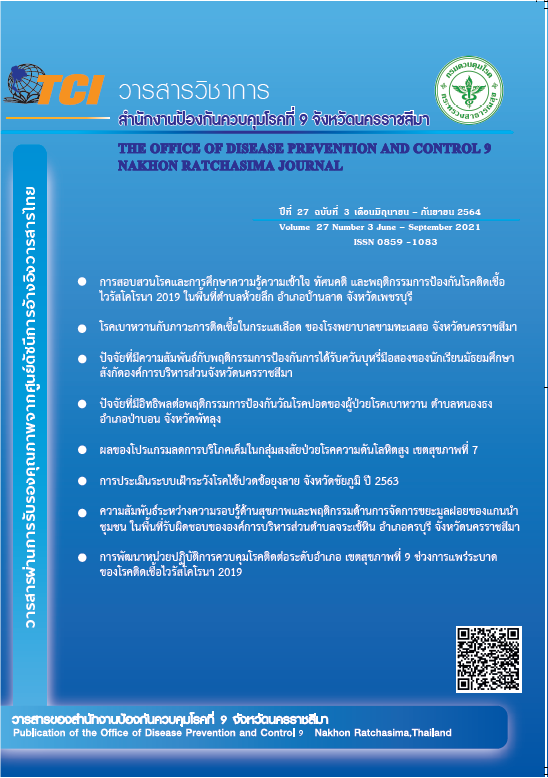Effects of a Salty Reduction Program in the Suspected Hypertensive Patients in Health Area 7
Keywords:
Salty Reduction Program, Salty Consumption, Suspected hypertensive patients, HypertensionAbstract
This study was a quasi-experimental research that aimed to assess the effects of the salinity reduction program in suspected hypertensive patients in health region 7. The study was conducted between December 2018 and July 2019, using a participatory learning process which consisted of providing advice, consultation, and exchanging techniques for reducing salt and sodium intake. District sampling was conducted in 50 percent of the 77 districts. One community per district was randomly assigned, then a simple random sampling of 50 suspected hypertensive patients, totaling 1,903 persons. Data was collected by means of knowledge assessment, physical examination, and food salinity measurement. Data was evaluated at month 0, 1 and 2, and the data were analyzed by descriptive and inferential statistics to compare the knowledge, sodium, salt, and blood pressure before and after with Paired t-test statistics. Comparisons were made of blood pressure before and after proceeding with Stuart-Maxwell test, with the statistical significance level of 0.05. The results showed that knowledge score was increased significantly (Mean difference = 3.13; 95% CI: 3.03–3.24, p-value < 0.001). The dietary sodium after the study, the mean was 305.05 mg (SD = 115.89), was lower significantly (Mean difference = 94.99; 95% CI: 90.08–99.90, p-value < 0.001). The proportion of blood pressure levels before and after being significantly different at the 0.05 level (Stuart-Maxwell Chi-square = 592.78, p-value < 0.001). Assessment of dietary salinity and blood pressure monitoring at home in suspected hypertensive patients can raise awareness of the benefits of reducing salt consumption, including lowering blood pressure and lowering the possibility of related coronary diseases. Health literacy of the effects of high salt and sodium consumption should be encouraged. The study sample is a good model for expanding the at-risk group in the community and to encourage public policy for reducing salinity, disease, and increasing health benefits in a sustainable manner.
References
World Health Organization. Global Action Plan for the Prevention and Control of Noncommunicable Diseases
-2020 [Internet]. 2013 [Cited 11 October 2018]. Available from:
https://apps.who.int/iris/bitstream/handle/10665/94384/
_eng.pdf;jsessionid=6000A27373CC5DD99D45554F9DB3292A?sequence=1.
สำนักโรคไม่ติดต่อ กรมควบคุมโรค. ข้อมูลโรคไม่ติดต่อ[อินเทอร์เน็ต].2016 [เข้าถึงเมื่อ 16 กันยายน 2562]. เข้าถึงได้
จาก:www.thaincd.com/2016/mission/documents-detail.php?id=13486&tid=32&gid=1-020.
Health Data Center. ข้อมูลเพื่อตอบสนอง Service Plan สาขาโรคไม่ติดต่อ (NCD, DM, HT, CVD) [อินเทอร์เน็ต]. 2562 [เข้าถึง
เมื่อ 16 พฤศจิกายน 2561]. เข้าถึงได้จาก:https://hdcservice.moph.go.th/hdc/reports/page.php?
cat_id=b2b59e64c4e6c92d4b1ec16a599d882b.
กาญจนา มณีทัพ, สมจิต แดนสีแก้ว. สถานการณ์การบริโภคเกลือของผู้ป่วยความดันโลหิตสูง ตำบลทางขวาง อำเภอแวงน้อย จังหวัด
ขอนแก่น. วารสารการพยาบาลและการดูแลสุขภาพ 2560. 35(4): 139-49.
สมาคมความดันโลหิตสูงแห่งประเทศไทย. ลดเค็ม พิชิตภัยเงียบ [อินเทอร์เน็ต]. 2560 [เข้าถึงเมื่อ 16 กันยายน 2562]. เข้าถึงได้จาก:
http://www.thaihypertension.org/files/237_1.LowSalt.pdf.
สำนักสถิติแห่งชาติ. การสำรวจพฤติกรรมการบริโภคอาหารของประชากร พ.ศ. 2560. กรุงเทพฯ: สำนักงานสถิติแห่งชาติ; 2561.
ยุทธศาสตร์การลดการบริโภคเกลือและโซเดียม ในประเทศไทย พ.ศ. 2559-2568. กระทรวงสาธารณสุข; 2559.
Irwan MA, Kato M, Kitaoka K, Ueno E, Tsujiguchi H, Shogenji M. Development of the salt reduction and efficacy-
maintenance program in Indonesia. Nursing and Health Sciences 2016.18:519–32.
สมาคมความดันโลหิตสูงแห่งประเทศไทย. แนวทางการรักษาความดันโลหิตสูงในเวชปฏิบัติทั่วไป พ.ศ. 2562. พิมพ์ครั้งที่ 1. สมาคม
ความดันโลหิตสูงแห่งประเทศไทย. กรุงเทพมหานคร. 2562.
Kuder GF, Richardson MW. The theory of estimation of test reliability. Psychometrika 1937.2:151-60.
Best JW. Research in Education. 3rd ed. Englewood Cliffs, New Jersey: Prentice Hall, Inc; 1977.
Fleiss JL. Statistical Methods for Rates and Proportions.New York: John Wiley & Sons; 1981.
World Health Organization. The Asia-Pacific perspective: redefinding obesity and its treatment [Internet]. 2000
[Cited 11 October 2018]. Available from:
https://apps.who.int/iris/bitstream/handle/10665/206936/0957708211_eng.pdf?sequence=1&isAllowed=y
ทิพาพร ราชาไกร. การพัฒนารูปแบบชุมชนลดการบริโภคเค็มในการป้องกันโรคความดันโลหิตสูง จังหวัดกาฬสินธุ์ ปีงบประมาณ
วารสารวิจัยและพัฒนาสิ่งแวดล้อมศึกษา 2562. 4(4): 153-64.
สม นาสอ้าน, ทิพาพร ราชาไกร. การพัฒนารูปแบบลดการบริโภคเค็มในกลุ่มสงสัยป่วยความดันโลหิตสูง. วารสารสำนักงานป้องกัน
ควบคุมโรคที่ 7 ขอนแก่น 2563. 27(3): 99-110.
พรทิพย์ นิ่มขุนทด. ความสัมพันธ์ระหว่างพฤติกรรมการรับประทานอาหารเค็มกับโรคความดันโลหิตสูงและโรคหลอดเลือดหัวใจ:
มหาวิทยาลัยเทคโนโลยีสุรนารี; 2559.
ชลธิชา บุญศิริ, นพวรรณ เปียซื่อ, พรรณวดี พุธวัฒนะ, สุรศักดิ์ กันตชูเวสศิริ. ผลของโปรแกรมส่งเสริมการบริโภคอาหารลดโซเดียม
ต่อความรู้และปริมาณโซเดียมในการปัสสาวะของนักศึกษาพยาบาล. วารสารสภาการพยาบาล 2560. 32(3): 104-19.
สายหยุด มูลเพ็ชร์. รายงานการวิจัยฉบับสมบูรณ์. การสำรวจปริมาณโซเดียมที่ขับออกมาทางปัสสาวะและปัจจัยที่มีผลต่อการกินเค็ม
ในกลุ่มผู้ที่มีความเสี่ยงต่อการเป็นความดันโลหิตสูงโรงพยาบาลตำบลดอนแก้ว อำเภอแม่ริม จังหวัดเชียงใหม่. 2558.
สำนักโรคไม่ติดต่อ กรมควบคุมโรค. รูปแบบการบริการ ป้องกันควบคุมเบาหวาน ความดันโลหิตสูง สำหรับสนับสนุนการดำเนินงาน
NCD Clinic Plus. พิมพ์ครั้งที่ 1. จังหวัดนนทบุรี: โรงพิมพ์ชุมนุมสหกรณ์การเกษตรแห่งประเทศไทย; 2560.

Downloads
Published
How to Cite
Issue
Section
License
บทความที่ลงพิมพ์ในวารสารวิชาการสำนักงานป้องกันควบคุมโรคที่ 9 จังหวัดนครราชสีมา ถือว่าเป็น
ลิขสิทธิ์ สำนักงานป้องกันควบคุมโรคที่ 9 จังหวัดนครราชสีมา



